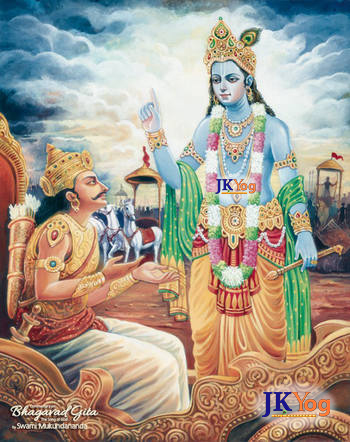

ओमित्येकाक्षरं ब्रह्म व्याहरन्मामनुस्मरन् |
य: प्रयाति त्यजन्देहं स याति परमां गतिम् || 13||
oṁ ityekākṣharaṁ brahma vyāharan mām anusmaran
yaḥ prayāti tyajan dehaṁ sa yāti paramāṁ gatim
om ityekaksharam brahma vyaharan mam anusmaran
yah prayati tyajan deham sa yati paramam gatim
BG 8.13: One who departs from the body while remembering Me, the Supreme Personality, and chanting the syllable Om, will attain the supreme goal.

Start your day with a nugget of timeless inspiring wisdom from the Holy Bhagavad Gita delivered straight to your email!
The Vedic scriptures state that at the beginning of creation, God first created sound. With sound, He created space and then continued with the rest of the creation process. That primordial sound was the sacred syllable OM it is also called Pranav—the sound manifestation of the Brahman. It represents the formless aspect of the Supreme Lord, without any attributes and virtues.The Bible also mentions this in John 1:1: In the beginning was the Word, and the Word was with God, and the Word was God.
The sound Om pervades the entire creation; it is imperishable and infinite like God Himself. Hence, it is also called anāhat nād. In the Vedic philosophy, it is conferred as the mahā vākya, or the Great Sound Vibration of the Vedas and often attached to the beginning of the Vedic mantras, as bīja (seed or core) mantra similar to hrīṁ, klīṁ, etc.
For proper chanting of the sacred word OM, the emphasis is on the vibrations of three letters: A… U… M… One starts by making an “A” sound from the belly, with an open mouth and throat; it then merges into a “U” created in the middle of the mouth. Finally, it ends in chanting “M” with a closed mouth.
Devotees consider the word Om as the impersonal form of God. In ashtanga yoga, the Praṇav sound is considered the object of meditation. In this verse, Shree Krishna is describing the process of meditation with regard to the ashtanga yoga sadhana. He states that to focus the mind on God, one should chant “Óm” while practicing austerities and maintaining the vow of celibacy.
However, the devotees who take the path of bhakti yoga prefer to meditate upon the personal Names of the Lord. They experience greater sweetness in God’s bliss when they meditate on; the personal Name and Forms of God, such as Ram, Krishna, Shiv, etc.
If you compare; the pleasure experienced by two ladies, one who is an expectant mother and one who has her new-born baby in her lap. The experience is much sweeter for the new mother. Seeing her beautiful baby, she even forgets the discomfort and pain she had experienced during childbirth.
The time of death is the final test of our meditation. As death is said to be intensely painful and despite the pain, those who are able to focus on God even at that last moment; attain Him. And on leaving the body, their souls reach His divine abode. However, to achieve such a state is very difficult; it requires continuous practice throughout one’s life. The merciful Lord Krishna shows us an easier path in the next verse.